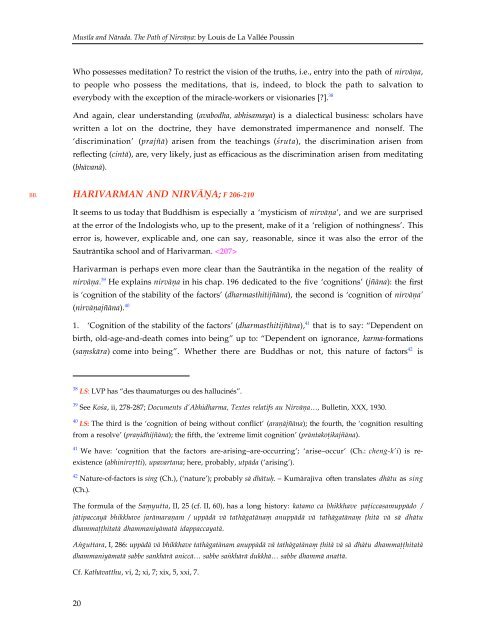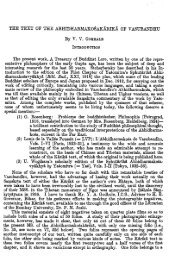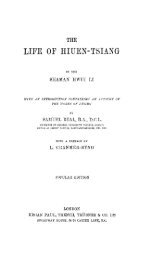La Vallée Poussin Musīla and Nārada. The Path - Gampo Abbey
La Vallée Poussin Musīla and Nārada. The Path - Gampo Abbey
La Vallée Poussin Musīla and Nārada. The Path - Gampo Abbey
Create successful ePaper yourself
Turn your PDF publications into a flip-book with our unique Google optimized e-Paper software.
Musıla <strong>and</strong> N›rada. <strong>The</strong> <strong>Path</strong> of Nirv›˚a: by Louis de <strong>La</strong> <strong>Vallée</strong> <strong>Poussin</strong><br />
Who possesses meditation? To restrict the vision of the truths, i.e., entry into the path of nirv›˚a,<br />
to people who possess the meditations, that is, indeed, to block the path to salvation to<br />
everybody with the exception of the miracle-workers or visionaries [?]. 38<br />
And again, clear underst<strong>and</strong>ing (avabodha, abhisamaya) is a dialectical business: scholars have<br />
written a lot on the doctrine, they have demonstrated impermanence <strong>and</strong> nonself. <strong>The</strong><br />
‘discrimination’ (prajñ›) arisen from the teachings (Ÿruta), the discrimination arisen from<br />
reflecting (cint›), are, very likely, just as efficacious as the discrimination arisen from meditating<br />
(bh›van›).<br />
BB. HARIVARMAN AND NIRVfi≤A; F 206-210<br />
It seems to us today that Buddhism is especially a ‘mysticism of nirv›˚a’, <strong>and</strong> we are surprised<br />
at the error of the Indologists who, up to the present, make of it a ‘religion of nothingness’. This<br />
error is, however, explicable <strong>and</strong>, one can say, reasonable, since it was also the error of the<br />
Sautr›ntika school <strong>and</strong> of Harivarman. <br />
Harivarman is perhaps even more clear than the Sautr›ntika in the negation of the reality of<br />
nirv›˚a. 39 He explains nirv›˚a in his chap. 196 dedicated to the five ‘cognitions’ (jñ›na): the first<br />
is ‘cognition of the stability of the factors’ (dharmasthitijñ›na), the second is ‘cognition of nirv›˚a’<br />
(nirv›˚ajñ›na). 40<br />
1. ‘Cognition of the stability of the factors’ (dharmasthitijñ›na), 41 that is to say: “Dependent on<br />
birth, old-age-<strong>and</strong>-death comes into being” up to: “Dependent on ignorance, karma-formations<br />
(sa˙sk›ra) come into being”. Whether there are Buddhas or not, this nature of factors 42 is<br />
38 LS: LVP has “des thaumaturges ou des hallucinés”.<br />
39 See KoŸa, ii, 278-287; Documents d’Abhidharma, Textes relatifs au Nirv›˚a…, Bulletin, XXX, 1930.<br />
40 LS: <strong>The</strong> third is the ‘cognition of being without conflict’ (ara˚›jñ›na); the fourth, the ‘cognition resulting<br />
from a resolve’ (pra˚idhijñ›na); the fifth, the ‘extreme limit cognition’ (pr›ntako˛ikajñ›na).<br />
41 We have: ‘cognition that the factors are-arising–are-occurring’; ‘arise–occur’ (Ch.: cheng-k’i) is re-<br />
existence (abhinirv¸tti), upavartana; here, probably, utp›da (‘arising’).<br />
42 Nature-of-factors is sing (Ch.), (‘nature’); probably s› dh›tu¯. – Kum›rajıva often translates dh›tu as sing<br />
(Ch.).<br />
<strong>The</strong> formula of the Sa˙yutta, II, 25 (cf. II, 60), has a long history: katamo ca bhikkhave pa˛iccasamupp›do /<br />
j›tipaccay› bhikkhave jar›mara˚am / upp›d› v› tath›gat›na˙ anupp›d› v› tath›gat›na˙ ˛hit› v› s› dh›tu<br />
dhamma˛˛hitat› dhammaniy›mat› idappaccayat›.<br />
Aºguttara, I, 286: upp›d› v› bhikkhave tath›gat›nam anupp›d› v› tath›gat›na˙ ˛hit› v› s› dh›tu dhamma˛˛hitat›<br />
dhammaniy›mat› sabbe sankh›r› anicc›… sabbe saºkh›r› dukkh›… sabbe dhamm› anatt›.<br />
Cf. Kath›vatthu, vi, 2; xi, 7; xix, 5, xxi, 7.<br />
20






